 W
WAtelopus is a large genus of true toads, commonly known as harlequin toads or stubfoot toads, from Central and South America, ranging as far north as Costa Rica and as far south as Bolivia. Atelopus species are small, generally brightly colored, and diurnal. Most species are associated with mid-to-high elevation streams. This genus has been greatly affected by amphibian declines, and many species are now considered endangered, while others already are extinct. While threatened by habitat loss, pollution, and introduced species, the primary cause of these declines appears to be the chytrid fungus Batrachochytrium dendrobatidis. For example, there are 32 known Atelopus species in Ecuador. One of these is data deficient, two are endangered and the remaining are critically endangered. Almost half the Ecuador species have not been recorded in a decade or more and are likely extinct. In some species conservationists have established captive colonies as a safeguard. However, numerous Atelopus species have been rediscovered decades after their last sighting, such as A. arsyescue, A. mindoensis, A. bomolochos, A. ignescens, A. balios, A. longirostris, A. subornatus and A. varius.
 W
WThe starry night toad is a species of toad in the family Bufonidae endemic to the Sierra Nevada de Santa Marta, Colombia. Its natural habitats are sub-Andean and Andean forests, sub-páramo and páramo at 2,000–3,500 m (6,600–11,500 ft) above sea level. Reproduction takes place in fast-flowing rivers. It is named after its unique coloration, being largely black with white spots.
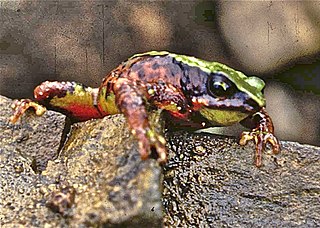 W
WAtelopus arthuri, Arthur's stubfoot toad, is a species of toad in the family Bufonidae endemic to Ecuador. Its natural habitats are subtropical or tropical moist montane forests, subtropical or tropical high-altitude grasslands, and rivers. It is threatened by habitat loss. It has not been seen for more than 20 years and is considered probably extinct.
 W
WAtelopus balios, the Rio Pescado stubfoot toad, is a species of toad in the family Bufonidae. It is endemic to southwestern Ecuador, with records from Pacific lowlands in Azuay, Cañar, and Guayas Provinces. It is a rare species that was already suspected to be extinct, but a single specimen was discovered in 2011 by a team from Conservation International during a hunt for missing amphibians. The decline in amphibian populations is well documented. The Atelopus balios is Critically Endangered as a result of the widespread amphibian Chytridiomycosis fungus that has decimated other amphibian populations. There are only 10 known findings of the tadpole, Atelopus balios.
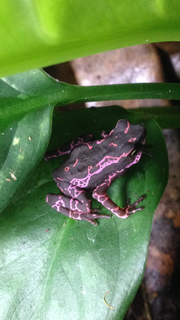 W
WAtelopus barbotini is a species of toad in the family Bufonidae. It is endemic to the uplands of central French Guiana.
 W
WThe Cayenne stubfoot toad, known in French as atélope jaunâtre, is a species of toad in the family Bufonidae found in northeastern French Guiana and in the adjacent Brazilian state Amapá. Its natural habitats are lowland primary forest where it is known from near fast-flowing, small streams. It is locally common. There are no major threats at present.
 W
WAtelopus certus, the Darien stubfoot toad or Toad Mountain harlequin frog, is a species of toad in the family Bufonidae endemic to Panama.
 W
WAtelopus chiriquiensis, the Chiriqui harlequin frog or Lewis' stubfoot toad, is a species of toad in the family Bufonidae found in the Cordillera de Talamanca in Costa Rica and western Panama. Its natural habitats are stream margins in lower montane wet forests and rainforests. Its elevational range is 1,400–2,500 m (4,600–8,200 ft) asl.
 W
WAtelopus cruciger, also known as the Veragua stubfoot toad or Rancho Grande harlequin frog, is a species of toad in the family Bufonidae. It is endemic to Venezuela and is known from the central Venezuelan Coastal Range. The species was already suspected to be extinct because, despite considerable effort, none had been found since 1986. However, in 2003, a small population was found, with few other locations discovered later. It is mainly threatened by chytridiomycosis. It is locally called sapito rayado.
 W
WThe elegant stubfoot toad or Pacific jambato frog is a species of toad in the family Bufonidae found in lowlands and Andean slopes of northwest Ecuador to 1,140 m (3,740 ft) asl and on the Gorgona Island, off southwest coast of Colombia. It was described by George Albert Boulenger in 1882 based on a specimen collected by Edward Whymper. It is known in Spanish as rana jambato del Pacífico or simply jambato del Pacífico.
 W
WAtelopus eusebiodiazi is a species of toads in the family Bufonidae. It is endemic to northwestern Peru and only known from its type locality in Huamba, near Ayabaca, Piura Region. The specific name eusebiodiazi honors Eusebio Diaz, taxidermist at the Museum of Natural History, Lima, and the collector of the holotype.
 W
WAtelopus exiguus is a species of toad in the family Bufonidae. It is endemic to Ecuador and only known from the area of its type locality in the Azuay Province of southern Ecuador, in the sub-páramo and páramo of Cordillera Occidental. Common name Mazán jambato frog has been proposed for it.
 W
WAtelopus franciscus, the Central Coast stubfoot toad, is a species of toad in the family Bufonidae, endemic to the central coastal region of French Guiana. It is a locally common, diurnal species found near fast-flowing small streams and creeks in lowland rainforest. Many authors have suggested this taxon might be a synonym of Atelopus flavescens. It is threatened by habitat loss.
 W
WAtelopus glyphus, the Pirri harlequin frog or Pirri Range stubfoot toad, is a species of toad in the family Bufonidae found in Colombia and Panama within the Northwestern Andean montane forests. Its natural habitats are subtropical or tropical moist montane forests and rivers.
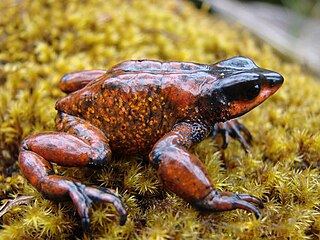 W
WThe Guajira stubfoot toad or Carrikeri harlequin frog, Atelopus carrikeri, is a species of toad in the family Bufonidae. It is about 5 cm (2.0 in) long and typically black, though some populations have orange coloration. This species is endemic to the Sierra Nevada de Santa Marta mountain range of northern Colombia. It is critically endangered because of the chytrid fungus, Batrachochytrium dendrobatidis, and habitat destruction due to agriculture. The species had not been seen from 1994 until it was rediscovered in early 2008.
 W
WAtelopus ignescens, the Jambato toad or Quito stubfoot toad, is a species of toad in the family Bufonidae. It is endemic to the northern Andes of Ecuador. This once abundant species was believed to be extinct until its rediscovery in 2016. The specific name ignescens means "to catch fire", presumably in reference to the orange ventral color of this species.
 W
WAtelopus laetissimus is a species of toad in the family Bufonidae. It is endemic to Colombia and only known from the area of its type locality in the northwestern part of the Sierra Nevada de Santa Marta, in the Magdalena.
 W
WAtelopus limosus, the limosa harlequin frog is an endangered species of toad in the family Bufonidae endemic to Panama. Its natural habitats are stream banks in tropical moist lowland forests and rivers of the Chagres watershed in central Panama.
 W
WAtelopus longirostris is a species of harlequin frog, a member of the family of true toads (Bufonidae). It has been recorded only in northern Ecuador. Records from Colombia probably represent different species. As of mid-2017, it is listed as extinct by the IUCN, but was rediscovered in 2016 after more than two decade with no sightings. The scientific name of this species means "long-snout" and the species has been named in Spanish as the jambato hocicudo. Common names longnose stubfoot toad, scrawny stubfoot-toad, and longnose sharlequin frog have been coined for it.
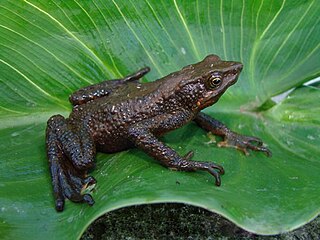 W
WAtelopus nahumae is a species of toad in the family Bufonidae. It is endemic to Colombia and only known from humid montane forest of Sierra Nevada de Santa Marta in the Magdalena, La Guajira, and Cesar Departments.
 W
WAtelopus nanay is a species of toads in the family Bufonidae.
 W
WAtelopus onorei is a small species of bright yellow and green toads in the family Bufonidae. It is endemic to Ecuador and is only known from the vicinity of its type locality on the western slope of the Cordillera Occidental in the Azuay Province. It has not been seen since 1990 and may now be extinct, but it is possible that overlooked populations remain.
 W
WAtelopus palmatus is a species of toad in the family Bufonidae. It is endemic to the Cordillera Oriental of eastern Ecuador and is known from the Napo and Pastaza Provinces at elevations of 1,150–1,740 m (3,770–5,710 ft) above sea level. Its type locality is "Rio Pastaza".
 W
WThe Panamanian golden frog, also known as Cerro Campana stubfoot toad and other names, is a species of toad endemic to Panama. Panamanian golden frogs inhabit the streams along the mountainous slopes of the Cordilleran cloud forests of west-central Panama. While the IUCN lists it as critically endangered, it may in fact have been extinct in the wild since 2007. Individuals have been collected for breeding in captivity in a bid to preserve the species. The alternative common name, Zetek's golden frog, and the epithet zeteki both commemorate the entomologist James Zetek.
 W
WAtelopus patazensis is a species of toads in the family Bufonidae. It is endemic to Peru and only known from its type locality in Quebrada Los Alisos, near Pataz in the La Libertad Region. There is, however, an unverified observation from Llacuabamba, about 40 km south of Pataz.
 W
WAtelopus petersi is a species of toads in the family Bufonidae. It is endemic to Ecuador and is known from the Cordillera Oriental in the Napo Province and more provisionally, in the Chimborazo Province. The specific name petersi honors James A. Peters, an American zoologist who collected the first specimens of this species in 1962 and provided a description under the name Atelopus pachydermus. Common names Peters' stubfoot toad and Peters' jambato toad have been coined for it.
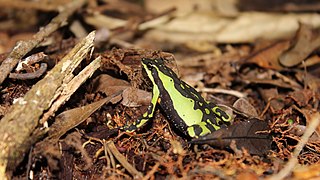 W
WAtelopus pulcher is a species of toad in the family Bufonidae. It is endemic to eastern Peru where it is found in the Huallaga River drainage; its range might extend to Ecuador. Its natural habitats are lowland and premontane tropical forests. It is a diurnal and terrestrial species that breeds in streams.
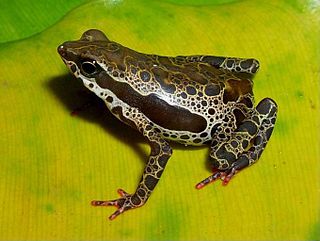 W
WAtelopus spumarius is a species of toad in the family Bufonidae. It is native to Brazil, Colombia, Ecuador, French Guiana, Guyana, Peru and Suriname.
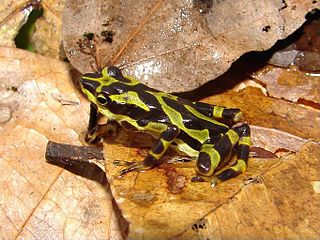 W
WAtelopus spurrelli is a species of toad in the family Bufonidae. It is endemic to Colombia and occurs in the Pacific lowlands and foothills of the Cordillera Occidental. The specific name spurrelli honors Herbert George Flaxman Spurrell, a British physician and zoologist. Common name Condoto stubfoot toad has been coined for this species.
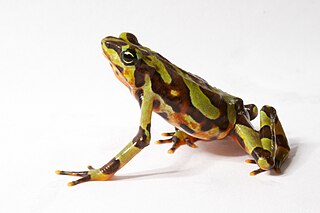 W
WAtelopus varius, the Costa Rican variable harlequin toad or clown frog, is a small Neotropical true toad from the family Bufonidae. Once ranging from Costa Rica to Panama, A. varius is now listed as critically endangered and has been reduced to a single remnant population near Quepos, Costa Rica and has only relict populations in western Panama (IUCN). Recent variation in air temperature, precipitation, stream flow patterns, and the subsequent spread of a pathogenic chytrid fungus (Batrachochytrium dendrobatidis) linked to global climate change have been the leading cause of decline for A. varius. A. zeteki has been considered a subspecies of A. varius, but is now generally considered a separate species.